|
||||||
|
CENTAUREA. Knapweeds, Star-thistles and Cornflowers. [Asteraceae] |
|
|
Forty species of Centaurea are recorded in Britain. These include the native Common Knapweed (C. nigra), Greater Knapweed (C. scabiosa) and Slender Knapweed (C. debeauxii) and introduced Knapweeds, Star-thistles and Cornflowers. Twenty-two or twenty-three British miners are recorded on Centaurea. Elsewhere the tephritid Philophylla caesio is recorded as a miner in the petioles of Urtica sp. by Ferrar (1987), Beiger (1968) and White (1988), although there are unconfirmed records on Caprifoliaceae and Asteraceae, which seems an odd combination of hosts. A key to the European miners recorded on Centaurea is provided in Bladmineerders van Europa. |
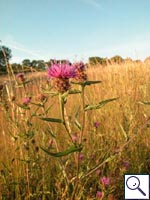 Common Knapweed Centaurea nigra |
Key for the identification of the known mines of British |
|||||||||||||||||||||||||||||||||
Note: Diptera larvae may live in a corridor mine, a corridor-blotch mine, or a blotch mine, but never in a case, a rolled or folded leaf, a tentiform mine or sandwiched between two more or less circular leaf sections in later instars. Pupation never in a cocoon. All mining Diptera larvae are leg-less maggots without a head capsule (see examples). They never have thoracic or abdominal legs. They do not have chewing mouthparts, although they do have a characteristic cephalo-pharyngeal skeleton (see examples), usually visible internally through the body wall. The larvae lie on their sides within the mine and use their pick-like mouthparts to feed on plant tissue. In some corridor miners frass may lie in two rows on alternate sides of the mine. In order to vacate the mine the fully grown larva cuts an exit slit, which is usually semi-circular (see Liriomyza huidobrensis video). The pupa is formed within the hardened last larval skin or puparium and as a result sheaths enclosing head appendages, wings and legs are not visible externally (see examples). See Key to non-Diptera. |
|||||||||||||||||||||||||||||||||
1a >Stem-miner: A narrow, inconspicuous stem mine. Pupation at the end of the mine (Spencer, 1976: 64). Fine, upper- or lower-surface corridor, ending in a thick vein. From there the mine extends finally to the rind of the stem. There also the pupation takes place, usually not far from the root collar. Mines in the stem rind often are conspicuous through a red discoloration. |
|||||||||||||||||||||||||||||||||
|
|||||||||||||||||||||||||||||||||
Ophiomyia curvipalpis (Zetterstedt, 1848) [Diptera: Agromyzidae]. |
|||||||||||||||||||||||||||||||||
1b > Leaf miner |
|||||||||||||||||||||||||||||||||
| 3 | |||||||||||||||||||||||||||||||||
| 2b > Leaf-miner: Mine not primarily associated with mid-rib. | |||||||||||||||||||||||||||||||||
3a > Leaf-miner: A distinctive mine primarily above mid-rib, with irregular short lateral offshoots into leaf blade. Pupation external (Spencer, 1972: 51 (fig. 172), 55; Spencer, 1976: 270, 271 (fig. 486)). Branched, whitish, upper-surface corridor; main axis overlying the midrib; side branches overlying the main lateral veins. (In Campanula and Phyteuma the mine is much less branched, sometimes nothing more than a corridor on top of the midrib). Frass in rather long strings. Usually the mines begins as a long and narrow, shallow, tortuous lower-surface corridor that ends upon the midrib but otherwise is not associated with the leaf venation. Often this initial corridor is filled with callus, and then even less conspicuous. Pupation outside the mine. A linear mine on the upper surface, usually following the midrib and showing side branches along the veins. The frass is in strings. |
|||||||||||||||||||||||||||||||||
|
|||||||||||||||||||||||||||||||||
|
|||||||||||||||||||||||||||||||||
Liriomyza strigata (Meigen, 1830) [Diptera: Agromyzidae]. |
|||||||||||||||||||||||||||||||||
3b > Leaf-miner: Larva feeds along the mid-rib, predominantly on the lower surface and there is little evidence of gall-like swelling. Pupation takes place at the base of the midrib (Spencer, 1976: 496). |
|||||||||||||||||||||||||||||||||
|
|||||||||||||||||||||||||||||||||
Phytomyza continua Hendel, 1920 [Diptera: Agromyzidae]. |
|||||||||||||||||||||||||||||||||
3c > Leaf-miner: A long, whitish linear-blotch mine, frequently associated with the mid-rib (Spencer, 1976: 321 (fig. 583), 323). Unusually long (up to 16 cm), upper-surface, whitish corridor. Often the corridor crosses itself so repeatedly that a secondary blotch develops. Sometimes a few small grains of frass in the initial part of the mine. Otherwise the mine is either completely free from frass, or a few big lumps are deposited at the very end of the corridor. Pupation outside the mine. The mine is illustrated in the Encyclopedia of Life. |
|||||||||||||||||||||||||||||||||
|
|||||||||||||||||||||||||||||||||
Aulagromyza similis (Brischke, 1880) [Diptera: Agromyzidae]. |
|||||||||||||||||||||||||||||||||
3d > Leaf-miner: A white mine along mid-rib, with offshoots into leaf blade. Pupation internal at base of mid-rib. In Asteraceae the larva mostly lives as a borer in the midrib of the leaves. From there short corridors are made into the blade. Also a corridor can be made overlying the midrib. In Euphorbia a small mine is made in the bracts of the inflorescence. The final mine strongly resembles the one of Liriomyza strigata, but the branches are vritually free from frass; this is acccumulated in the resting place of the larva, in the base of the midrib. There also pupation takes place. Forms a mine along the midrib and has feeding spurs into the leaf. Pupation is in the mine at the base of the midrib. |
|||||||||||||||||||||||||||||||||
|
|||||||||||||||||||||||||||||||||
Ophiomyia beckeri (Hendel, 1923) [Diptera: Agromyzidae]. |
|||||||||||||||||||||||||||||||||
4a > Leaf-miner: Mine a brownish blotch, at apex of leaf segment, several larvae feed together. Pupation in mine (Spencer, 1972b: 94). Greenish, later brownish, upper-surface blotch in the tip of a leaf segment, without a trace of an initial corridor. Often several larvae share a mine. No secondary feeding lines. Frass in numerous blackish green granules that are irregularly scattered. Pupation within the mine, pupariria loose in the mine. |
|||||||||||||||||||||||||||||||||
|
|||||||||||||||||||||||||||||||||
Phytomyza cinerea Hendel, 1920 [Diptera: Agromyzidae]. |
|||||||||||||||||||||||||||||||||
4b > Leaf-miner: A short, irregular, linear upper surface mine on any part of the leaf. Also recorded from young pods (Bland, 1997a). Long corridor mine. As a rule the first part of the mine is lower-surface, the later part upper-surface. Often the loops are so dense that a secondary blotch is the result. Because upper- and lower-surface corridor segments often cross, the mine obtains a strange array of transparant patches. There is no association with the midrib. Frass in strings and thread fragments. Pupation outside the mine; exit slit in upper epidermis. Mine not associated with the veins or midrib of the leaf (It is this character which enables distinction from another Agromyzid pest species - Liriomyza huidobriensis). The larvae may leave one leaf (if not large enough) and enter another leaf, via the petiole). It exits the leaf to pupate through a semi-circular slit in the upper surface of the leaf. |
|||||||||||||||||||||||||||||||||
|
|||||||||||||||||||||||||||||||||
Liriomyza bryoniae (Kaltenbach, 1858) [Diptera: Agromyzidae]. |
|||||||||||||||||||||||||||||||||
| 4c > Leaf-miner: Larvae feed singly. | |||||||||||||||||||||||||||||||||
5a > Leaf-miner: A short irregular linear mine with frass in more or less connected threads (Spencer, 1976: 238). Fairly long, upper-surface, little branched corridor; loops close together. Frass in pearl chains or strings. Pupation outside the mine. |
|||||||||||||||||||||||||||||||||
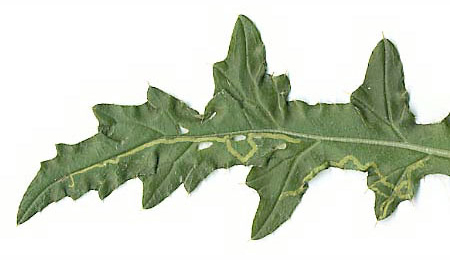 Mines of Phytomyza spinaciae on Cirsium arvense Image: © Willem Ellis (Bladmineerders van Europa) |
|||||||||||||||||||||||||||||||||
|
|||||||||||||||||||||||||||||||||
Phytomyza spinaciae Hendel, 1928 [Diptera: Agromyzidae]. |
|||||||||||||||||||||||||||||||||
5b > Leaf-miner: Mine not interparenchymal. |
|||||||||||||||||||||||||||||||||
6a > Leaf-miner: Mine linear, whitish, both upper and lower surface. Pupation internal, at the end of the mine with the anterior spiracles projecting through the epidermis (Spencer, 1976: 433). Upper-surface, less often lower-surface corridor. Frass in isolated grains. Pupation within the mine, usually in a lower-surface puparial chamber. A long whitish upper surface corridor, which eventually goes lower surface. |
|||||||||||||||||||||||||||||||||
|
|||||||||||||||||||||||||||||||||
Chromatomyia
horticola (Goureau, 1851) [Diptera: Agromyzidae] |
|||||||||||||||||||||||||||||||||
6b > Leaf-miner: A short irregular linear mine with frass in more or less connected threads. |
|||||||||||||||||||||||||||||||||
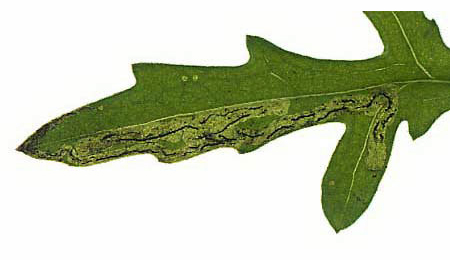 Mine of Liriomyza centaurea on Centaurea scabiosa Image: © Willem Ellis (Bladmineerders van Europa) |
|||||||||||||||||||||||||||||||||
|
|||||||||||||||||||||||||||||||||
Liriomyza centaureae Hering, 1927 [Diptera: Agromyzidae]. |
|||||||||||||||||||||||||||||||||
6c > Leaf-miner: A tightly coiled, almost blotch-like mine. |
|||||||||||||||||||||||||||||||||
6d > Leaf-miner: Mine long, distinctly greenish. Pupation in mine (Spencer, 1972b: 88). Branched, upper-surface corridor, with very irregular sides. Frass in isolared grains, maximally only 4 times their diameeter apart. Pupation within the mine. |
|||||||||||||||||||||||||||||||||
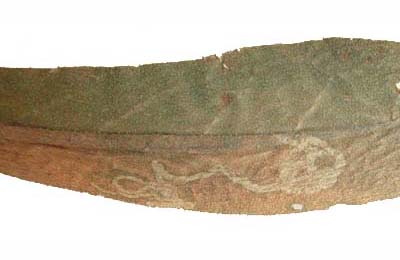 Mine of Phytomyza autumnalis on Centaurea nigra (Spencer Collection) Image: © Brian Pitkin |
|||||||||||||||||||||||||||||||||
|
|||||||||||||||||||||||||||||||||
Phytomyza autumnalis Griffiths, 1959 [Diptera: Agromyzidae]. |
|||||||||||||||||||||||||||||||||
6e > Leaf-miner:Strongly branched corridor mine which can become a secondary blotch. Frass in small grains. Pupation inside the mine (Spencer, 1976: 505 (fig. 883) or outside the mine. |
|||||||||||||||||||||||||||||||||
|
|||||||||||||||||||||||||||||||||
Phytomyza spoliata Strobl, 1906 [Diptera: Agromyzidae]. |
|||||||||||||||||||||||||||||||||
|
Key for the identification of the known mines of British |
Note: The larvae of mining Coleoptera, Hymenoptera and Lepidoptera may live in a corridor mine, a corridor-blotch mine, a blotch mine, a case, a rolled or folded leaf, a tentiform mine or sandwiched between two more or less circular leaf sections in later instars. Larva may pupate in a silk cocoon. The larva may have six legs (although they may be reduced or absent), a head capsule and chewing mouthparts with opposable mandibles (see video of a gracillarid larva feeding). Larvae of Hymenoptera and Lepidoptera usually also have abdominal legs (see examples). Frass, if present, never in two rows. Unless feeding externally from within a case the larva usually vacates the mine by chewing an exit hole. Pupa with visible head appendages, wings and legs which lie in sheaths (see examples). |
1a > Leaf-miner and case-bearer: The larva lives outside the mine, protected by a case, and feeds on the underlying plant tissues via a hole cut in the epidermis. From that point it eats away as much leaf tissue as it can reach without fully entering the mine. Mine does not contain frass (Coleophora species) |
1b > Leaf-miner, but not a case-bearer: The larva lives mainly inside the mine. Mine usually contains frass. In later instars the larva may live sandwiched between two more or less circular sections cut from the leaf. |
2a > Leaf-miner and case-bearer: A relatively large (12-15 mm), dark brown, lightly curved two-valved sheath case with a narrow ventral keel. Mouth angle 30-45. |
|
Coleophora conspicuella Zeller, 1849 [Lepidoptera: Coleophoridae]. |
2b > Leaf-miner and case-bearer: Larva mines leaves. The larva builds a case from silk, resembling a razor shell in appearance.. The full-grown case is 12 mm long and blackish-brown. The full grown larva lives in a blackish brown trivalved tubular silken case of about 8 mm. The mouth angle is 0°-10°, causing the case to lay almost flat on the leaf. |
|
Coleophora paripennella Zeller, 1839 [Lepidoptera: Coleophoridae]. |
2c > Leaf-miner and case-bearer: The larva forms a case, approximately 11-12 mm long, beneath a thistle leaf, although burdock may sometimes be used. The shape of the ochreous case varies as, when being enlarged, it is elongated first, and the girth increased subsequently. Yellow-brown to light grey tubular silken case with darker length lines. The case is fairly large (up to 17 mm) and very slender. The rear end is three-valved, the mouth angle about 50°. The larva feeds at the underside of the leaf. |
|
Coleophora peribenanderi Toll, 1943 [Lepidoptera: Coleophoridae]. |
3a > Leaf-miner: The eggs of this species are laid on a leaf, with the larvae mining the underside of the leaf, until a late instar when it feeds in a web under the midrib of the leaf, causing visible blotching on the upperside. Short, full depth corridor. The larva relatively long lives as a miner, but finally leaves the mine and continues living in spinning along the midrib at the leaf underside, from where windows are eaten in the leaf. |
 Mines of Agonopterix propinquella on Cirsium arvense Image: © Ian Smith (UKMoths) |
|
Agonopterix propinquella (Treitschke, 1835) [Lepidoptera: Depressariidae]. |
3b > Leaf-miner: In the first instar the larva mines the leaves, forming short, irregular, blotch-like mines, but in later instars it lives externally, feeding in spun leaves and often twisting those of tender shoots. Larval head light-brown or yellowish brown, edged with black postero-laterally, ocellar area blackish; prothoracic plate black edged with whitish anteriorly; abdomen dull dark green; pinacula distinct, black, sometimes brownish but with black bases to setae; anal plate large, black (Bradley et al., 1973). Small, full depth mine without a definite shape; little frass. Some silk is deposited in the mine. The larva soon leaves the mine and continues feeding among spun leaves. |
|
Cnephasia incertana (Treitschke, 1835) [Lepidoptera: Tortricidae]. |
3c > Leaf-miner: The larva makes a large number of untidy full depth mines. The mines contain hardly or no frass. The opening made by the larva in the underside of the leaf is irregular roundish, sometimes more of a slit, large in proportion to the size of the mine, and usually positioned at the side of the mine. The larva mines until just before the pupation, that takes place externally. |
|
Jordanita globulariae (Hübner, 1793) [Lepidoptera: Zygaenidae]. |
4c > Leaf-miner: The mine begins in the midrib, especially in a lower leaf, extending into the leaf disc, branching irregularly or pinnately, may also locally be blotch like. The mine is brown and very transparent. Sides very irregularly eaten out. Frass loosely dispersed or in a loose central line, buy may also be pressed against the sides of the corridor. The larva may also leave the mine and restart elsewhere. |
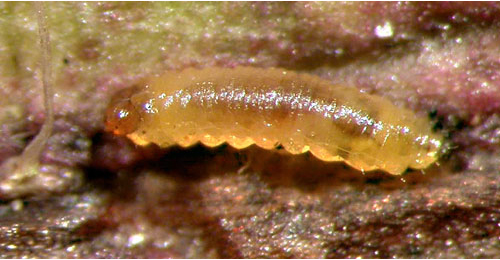 Orthochaetes setiger larva, dorsal Image: © Jean-Yves Baugnée (Bladmineerders van Europa) |
|
Orthochaetes setiger (Beck, 1817) [Coleoptera: Curculionidae]. |
4d > Leaf-miner: The larva makes a small full depth blotch, usually in the leaf tip. Frass concentrated in the centre of the mine The larva, when full grown, makes a globular cocoon in that same centre and pupates there. |
|
Pseudorchestes pratensis (Germar, 1821) [Coleoptera: Curculionidae]. |
3c > Long corridor, often following the leaf margin, with little frass and with the sides irrregularly eaten out. The first part of the corridor is full depth and makes a few close loops; the later part is more upper-surface and rather wide. Primary feeding lines often conspicuous. No morphological differences are known between the larva of S. rubidum and S. testaceum (Steinhausen, 1994a). However, there is a phenological difference: the larva of testaceum hibernates in the mine and continues feeding after winter; S. rubidum vacates the mine before winter and pupates in the soil. Hering (1957a) suggests that the identification of the beetles is an easy matter, but that is contradicted by Warchalowski (2003a). |
|
Sphaeroderma testaceum (Fabricius, 1775) [Coloeptera : Chrysomelidae] |
3d > Long corridor mine, without obvious relation with the leaf margin, with little frass and irregularly eaten out sides. The first part of the mine is full depth and makes a few close loops; the second part is upper-surface and considerably wider. Primary feedings lines often obvious. The larva is so broad that is completely fills the mine. No morphological differences are known between the larvae of S. rubidum and those of S. testaceum (Steinhausen, 1994a). The larva leaves the mine to pupate in the soil (the larva of testaceum hibernates in the mine.) Hering (1957a) suggests that the imagines are easily separated, but this is contradicted by Warchalowski (2003a). |
|
Sphaeroderma rubidum (Graells, 1858) [Coloeptera : Chrysomelidae] |
| Last updated 09-Jul-2020 Brian Pitkin | ||

